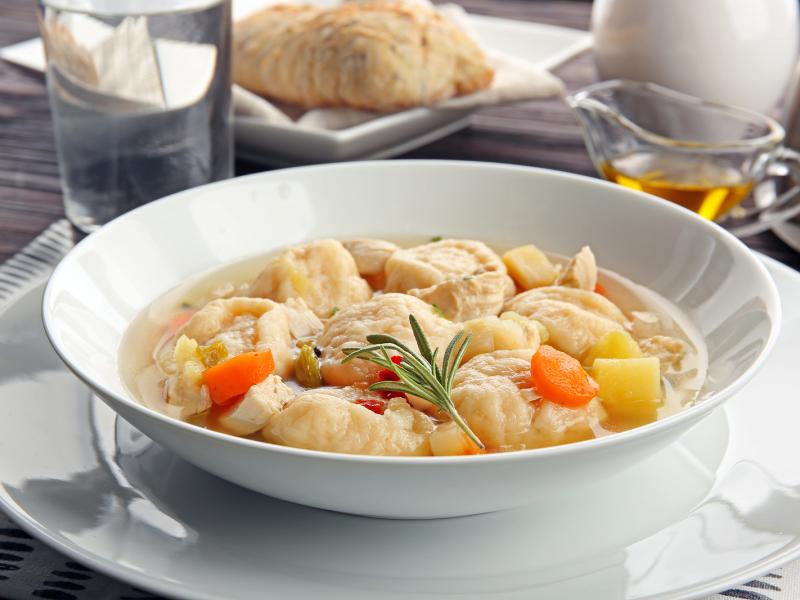
Chicken and Quick Dumplings
Macros / Serving Size
Protein 31g | Fat 11g | Carbs 42g
% Calories of Macros / Serving Size
Calories 393 | Protein 31% | Fat 25% | Carbs 43%
Nutrients / Serving Size
Fiber 4g | Sodium 882mg | Sat. Fat 2g
Ingredients (Serves 4)
- 12 oz. frozen boneless, skinless chicken breast, thawed according to package directions and cut into cubes.
- 2 tbsp. olive oil (divided)
- 2 cups mixed vegetables (corn, peas, carrots, green and/or lima beans, etc.), canned, frozen or fresh
- 4 cups low sodium chicken broth
- 1 1/3 cup all-purpose flower
- 3/4 tsp. baking soda
- 2 tsp. white vinegar
- 1/4 tsp. poultry seasoning (optional)
- 2/3 cup skim milk
- Pepper to taste
Directions
- Mix the vinegar and milk in a small bowl and set aside.
- In a large Dutch oven (large saucepan), heat 1 tbsp. olive oil over medium heat. Add the cubed chicken breast and cook for 4-5 minutes, until the outside of the chicken turns white. Toss constantly to prevent burning.
- Pour the chicken broth into the pot with the chicken and turn the heat up to medium-high. Add the vegetables.
- While the mixture comes to a boil, make the dumpling batter by adding the flour, baking soda, and seasoning (if using) to a medium-sized bowl and mix with a fork. Add the milk and the remaining oil. Stir with a fork until all the dry mix is dampened.
- Drop the mixture by heaping tablespoons into the boiling broth. Make sure the dumplings don't touch each other or drop them onto one another.
- Reduce the heat to medium and cook for 10 minutes. Stir gently on occasion to prevent the dumplings from touching or sticking to the bottom. Cover and reduce heat to medium-low. Cook for an additional 10 minutes. Add pepper to taste.
Notes
- Nutrition analysis based on the use of frozen vegetables and excludes optional ingredients.
- If using fresh or frozen vegetables, microwave for 6-8 minutes before adding to the broth. Do this before beginning step 1.
- Cooked leftover or rotisserie chicken can be used. Just skip step 1 and add it with step 2.
- Can use "low sodium chicken boullion, and make according to package directions to yield 4 cups.
Why this is Dietitian Approved
“Eat your vegetables!” Your grandparents were told by their grandparents to do so, and many of you likely have childhood memories of being encouraged to do the same. Plant foods like fruits and vegetables have been known for thousands of years to ward off ailments. Christopher Columbus made sure that before he left port, he had ample supplies of limes, lemons and potatoes to prevent scurvy among his crew, which is caused by lack of Vitamin C in the diet. The ancients used fruits and vegetables to treat and ward off many ailments.
During some of our nation’s challenges, such as the Great Depression, the rationing of supplies during the World Wars, harsh winters the early settlers faced, it is understandable that the consumption of fruits and vegetables to promote optimal may have been a challenge. Yet today, when our food supply is ample, and we don’t have to rely on growing our own crops, Americans, on average, eat far less than is recommended. Many studies show diets lacking in fruits and vegetables increase the risk of many chronic conditions such as heart disease, high blood pressure, cancer and obesity. Americans know this, but continue to consume far less produce than is recommended.
It is difficult to encourage children to consume fruits and vegetables if they don’t see the adults around them doing so and/or if they aren’t being served during meals or snacks. Children that don’t eat a variety of vegetables and fruits are less likely to do so as adults. The number of obese children is at an all-time high. Some point to decreased activity as the cause, while others point to decreased home prepared meals as the other. The fact is, both of these reasons play a large part, but so does a low intake of fruits and vegetables. This is because diets lacking in them also tend to be higher in fat, added sugars and calories. Excess calories cause excess weight in both children and adults. Be part of stopping the increase in obesity by eating fruits and vegetables with your kids. Increase the nutrient quality of the meals you serve to your family while decreasing the number of calories and unhealthy fat and added sugar. “Children learn from watching you. Prepare and eat your vegetables and your kids will, too!”
Aim to fill half your plate with fruits and vegetables for most meals and to switch most snacks to fruits and vegetables. Make a goal to consume at least 8 servings (a combo of fruits vegetables) per day. Not all servings need to be fresh produce. In fact, canned and frozen vegetables count too and may be higher in some nutrients than fresh produce. The best choices are those that are low in sodium, packed in their own juice with no added sugars, and don’t have sauces.
Use a combination of fresh, frozen and canned produce to help manage food dollars, limit waste, and meet the goal of increased consumption. Choose a variety of colors, buy fresh produce that is in season, and limit the number of starchy vegetables (corn, potatoes, lima beans and legumes) to no more than one serving per meal. Try to eat “Something Green” along with another color of produce at each meal.
This one-pot meal uses “mixed vegetables” to make a stick-to-your ribs comfort food. A combination of fresh, frozen, and canned can be used and the amounts and types of vegetables can be adjusted to what is ever on hand or what needs to be used up.
